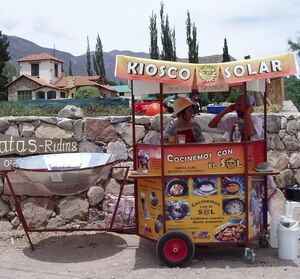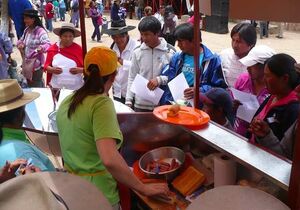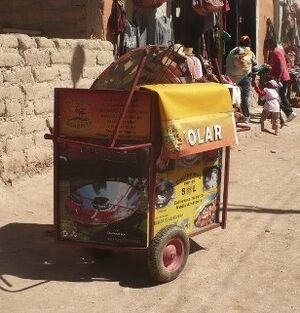Paul Hedrick (talk | contribs) mNo edit summary |
Paul Hedrick (talk | contribs) mNo edit summary |
||
| Line 8: | Line 8: | ||
Rojas, a teacher, took a course in solar cooking and decided that the cart would be a success at the EcoAndina Carnival. "It is not the same as having it on display," he says. |
Rojas, a teacher, took a course in solar cooking and decided that the cart would be a success at the EcoAndina Carnival. "It is not the same as having it on display," he says. |
||
| − | The Solar kiosk is an idea that has been brewing for years, in order to provide a cleaner, greener alternative to those who work in the sale of street food. This type of |
+ | The Solar kiosk is an idea that has been brewing for years, in order to provide a cleaner, greener alternative to those who work in the sale of street food. This type of food cart is deeply rooted in these cultures, where people (mostly women) armed with what items they have on hand and as best they can, resulting artefacts flimsy, uncomfortable and dangerous, if one that carry over a gas cylinder or a bed of hot coals. Not to mention the aesthetic or hygienic factor that hardly exist. The solar kiosk aims to promote a type of vending safer not only from the point of view of energy but also food. |
Another important project is the food and nutrition. The parabolic solar cooker used at the kiosk is being tested to prepare traditional cooking recipes such as tenderloin, burgers, hot dogs, roasted corn, tortilla-like bread, fried pies, donuts, etc. |
Another important project is the food and nutrition. The parabolic solar cooker used at the kiosk is being tested to prepare traditional cooking recipes such as tenderloin, burgers, hot dogs, roasted corn, tortilla-like bread, fried pies, donuts, etc. |
||
Revision as of 18:34, 27 February 2013

The Kiosco SOLAR

The solar powered kiosk has been a success at the Carnival of Puna.

The cart packs well for being transported.
A Kiosco SOLAR, or solar kiosk, is one of several solar powered mobile food carts in operation in northern Argentina. The project to introduce the food carts is sponsored by Fundación EcoAndina. During the celebrations of Carnival of Puna, which spans almost all of February, the intrepid promoters of the sun's energy walked a few new solar kiosks through the streets in Tilcara, Humahuaca, La Quiaca, Purmamarca and Uquía, tourist sites the northern province of Jujuy.
Each kiosk consists of a wheeled trolley, waterproof roof, and a parabolic solar cooker. "People are incredulous and astonished when the cart is in operation," says Marta Rojas, responsible for opening a kiosk this month in Tilcara, the ancient town that is the epicenter of the festivities. Since the late eighties, Fundación EcoAndina has worked in the development of various devices to harness sunlight in this arid region with scarce rainfall and vegetation, and wide temperature changes between daytime and nighttime. EcoAndina Foundation has had support from Germany, handled through the embassy in Argentina. Germany is a pioneer in the promotion of renewable energy and environmental stewardship. The policy also included development cooperation with ecological criteria requirements.
Rojas, a teacher, took a course in solar cooking and decided that the cart would be a success at the EcoAndina Carnival. "It is not the same as having it on display," he says.
The Solar kiosk is an idea that has been brewing for years, in order to provide a cleaner, greener alternative to those who work in the sale of street food. This type of food cart is deeply rooted in these cultures, where people (mostly women) armed with what items they have on hand and as best they can, resulting artefacts flimsy, uncomfortable and dangerous, if one that carry over a gas cylinder or a bed of hot coals. Not to mention the aesthetic or hygienic factor that hardly exist. The solar kiosk aims to promote a type of vending safer not only from the point of view of energy but also food.
Another important project is the food and nutrition. The parabolic solar cooker used at the kiosk is being tested to prepare traditional cooking recipes such as tenderloin, burgers, hot dogs, roasted corn, tortilla-like bread, fried pies, donuts, etc.
The Solar kiosk consists of two main parts: one for cooking using solar energy Solar incorporates the parabolic solar cooker, which focusses sunlight onto the bottom of cooking pots. The other part is like a small workshop that allows preparing cooking (this section includes a table, an exhibition area, a storage area for dishes, food and seasoning). As accessory features a canvas umbrella mode, wheels and handles for transport, either to walk or drive a bicycle. It also has space for locating the gas cylinder to the days no sun or cooking the evening. Logically, to return home from the kiosk vendor folds and is easily transportable.
The first units of Solar kiosk, designed by Virginia Bauso, have begun to operate in the city of Jujuy, Argentina, thanks to the involvement of WISIONS, an organization that is providing support for the continuation of the project.

